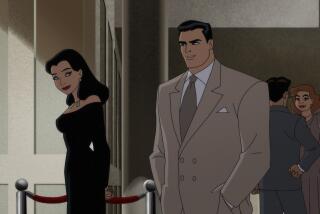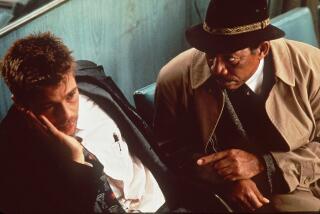Wholly rebound
Batman has finally come home. Not just to a story that painstakingly details his origins but to an ominous style that suits it beautifully.
Christopher Nolan’s “Batman Begins” disdains the mindless camp and compulsive weirdness that mostly characterized its quartet of predecessors and unapologetically positions its hero at the dark end of the street. With Christian Bale in the title role, this is a film noir Batman, a brooding, disturbing piece of work that starts slowly but ends up crafting a world that just might haunt your dreams.
In doing this, Nolan, who co-wrote with comic book specialist David S. Goyer, has in effect brought the franchise back to its modern origins. That would be the appearance in 1986, three years before the first Tim Burton film, of Frank Miller’s somber and ominous graphic novel “Batman: The Dark Knight Returns,” which repositioned Bob Kane’s 1939 Caped Crusader as a contemporary figure of almost existential torment.
Nolan’s intention with “Batman Begins,” however, is to go beyond this and create a myth grounded, as much as myth can be, in plain reality. He wants his story to be as plausible as possible, a human drama set in a believable world that looks like one we could live in but prefer not to. A film that underlines the notion that Batman is that unlikely comic-book hero who does without super powers, someone, the director has said, who “really is just a guy that does a lot of push-ups.” A heck of a lot of push-ups.
Nolan was a shrewd choice to revive a franchise that has gone eight years without a film. One of the qualities shared by his exceptional but otherwise diverse trio of previous films (“Following,” “Memento,” “Insomnia”) is how skillfully they are put together on a craft level. This “Batman” is a carefully thought out and consummately well-made piece of work, a serious comic-book adaptation that is driven by story, psychology and reality, not special effects.
In fact, with Wally Pfister (who shot Nolan’s last two films) as cinematographer, “Batman Begins” tries, despite using multiple special-effects houses, to avoid computer-generated imagery when it can. The film relies instead on shooting in real locations (from the streets of Chicago to a glacier in Vatnajokull, Iceland) and extensive use of miniatures, albeit some whose 35-feet height was made possible by constructing the sets in an enormous former blimp hangar with ceilings that rise to 200 feet. Nolan also did without a second unit, preferring the tonal unity he felt would come from directing everything himself.
Though his name might not have initially been on everyone’s lips, Christian Bale turns out to be an excellent fit for Nolan’s conception of the Dark Knight. And though he gained back the 63 pounds he lost for “The Machinist” and added an extra 20 for good measure, there is a leanness, a sense of purpose about his performance.
Always a humorless, almost sullen actor, Bale uses those qualities to create a painfully earnest character driven to a life of crime-fighting almost against his will. Bale even employed the physically uncomfortable Batsuit to his advantage: “I used the pain,” he has said, “as fuel for the character’s anger.”
Though Batman’s alter ego remains wealthy socialite Bruce Wayne, being the Dark Knight is not a rich man’s whim. “Batman Begins” shows us in great detail how Wayne became phobic about bats as a small boy, saw that phobia contribute to his parents’ untimely death and, driven by despair, ended up fighting the world in a prison in Bhutan.
It’s there that Wayne meets the shadowy Ducard (Liam Neeson), the emissary of Ra’s al Ghul and the sinister League of Shadows, a group fanatically dedicated to the stamping out of evil. They offer to make him one of their own, and in the group’s Himalayan redoubt Wayne learns more than ninja fighting techniques and methods of psychological warfare. He learns that embracing his own fear, specifically that old phobia toward bats, will be the key to his transformation.
If this scenario sounds a bit standard, it is in fact the least involving part of the film, for “Batman Begins” does not immediately kick into its highest gear. Though the early days of a hero have an intrinsic interest, especially when they are as thought out as they are here, this backstory has a tendency to feel too pulp-fiction familiar to completely enthrall.
Also a problem, and one that recurs sporadically through the film, is that not all of “Batman’s” actors have equal facility with the admittedly difficult assignment of being both comic-book archetypes and real people. Bale, who seems to feel this role in his bones, handles it with aplomb, but both Neeson and Katie Holmes, who appears later as a putative romantic interest, never seem to be sure which side of the coin to favor at any given moment.
Once Wayne returns to Gotham and sets his mind on being Batman, the noir possibilities of a black-caped avenger and a city at night help things immeasurably. Not only does production designer Nathan Crowley’s “Blade Runner”-influenced look suit the film, but the specifics of Batman lore -- the cave, the car, the suit, the swooping late-night flights -- benefit from that dark treatment as well.
The Gotham scenario also showcases the best of “Batman’s” supporting cast. On the side of light, both Michael Caine as Wayne family retainer, Alfred Pennyworth, and Morgan Freeman as the film’s version of James Bond’s armorer Q make this kind of acting look easier than it is.
On the side of darkness, Cillian Murphy, last seen in Danny Boyle’s “28 Days Later,” is terrifically chilling as the evil Dr. Jonathan Crane and his alter ego, the Scarecrow, who can turn a simple burlap sack into an object of total dread.
The most encouraging thing about “Batman Begins” is how individual director/co-writer Nolan has managed to make an $180-million epic. Director of photography Pfister, interviewed in American Cinematographer magazine, offered an explanation.
“One of the reasons Chris likes me to operate [the camera] is that it shrinks down the whole process for him,” Pfister says. “We could be sitting on the set with 150 people and huge setups, but when the camera rolls, it’s just Chris sitting next to me with a little monitor, and the actors right there in front of us. His entire universe is in that 12-foot area, which brings the process down to a more personal level.” Bringing an auteur sensibility to blockbuster material may sound next door to impossible, but “Batman Begins” shows it can be done. If you’re willing to do the push-ups.
*
‘Batman Begins’
MPAA rating: PG-13 for intense action violence, disturbing images and some thematic elements
Times guidelines: Definitely creepy
Released by Warner Bros. Pictures. Director Christopher Nolan. Producers Emma Thomas, Charles Roven, Larry Franco. Executive producers Benjamin Melniker, Michael E. Uslan. Screenplay Christopher Nolan and David S. Goyer. Story David S. Goyer, based on characters created by Bob Kane. Cinematographer Wally Pfister. Editor Lee Smith. Costumes Lindy Hemming. Music Hans Zimmer, James Newton Howard. Production design Nathan Crowley. Running time: 2 hours, 20 minutes.
In general release.
More to Read
Only good movies
Get the Indie Focus newsletter, Mark Olsen's weekly guide to the world of cinema.
You may occasionally receive promotional content from the Los Angeles Times.











